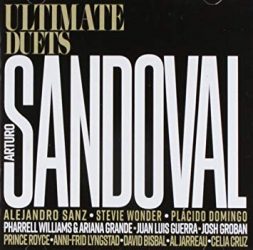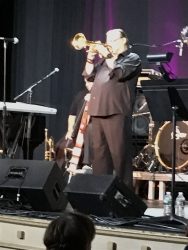Jazz Concert Review: Arturo Sandoval — Master Showman and Musician
Trumpeter Arturo Sandoval is a big personality and in this performance he was almost as much raconteur, comedian, and ringmaster as musician.

Trumpeter Arturo Sandoval can get up to the stratosphere. Photo: The Cabot.
By Steve Provizer
Technically, Arturo Sandoval’s trumpet playing is unassailable. His chops and technique have been matched by a very few — Eldridge, Shavers, Gillespie, Faddis. His range is phenomenal and his tonguing lightning fast. His knowledge of harmony and running chord changes is deep. Has he contributed a new “sound” to jazz? Probably not, but he has brought a number of techniques to their zenith.
Sandoval’s prodigious technique surfaced in his recent performance at the Cabot theatre in Beverly, along with occasional “look what I can do” playing — a blizzard of notes and use of the extreme top and the bottom of the trumpet’s register. Most trumpet players have a range of about 3 octaves. Lead players need to have 4 octaves and a few, like Cat Anderson, Maynard Ferguson, and a few others, can go up even higher. Sandoval can get up to that stratosphere. He can also go way down, into what is called the “pedal range.” Lower, in fact, than I have ever heard anyone else go, well into tuba range. Put the bottom together with the top and you approach 7 octaves. Pianos only have 7 and a third. The challenge is to use those extreme registers in a creative way. Sandoval knows they will inevitably draw oohs and aahs — but they sometimes stand outside the musical flow.
Sandoval is a big personality and in this performance he was almost as much raconteur, comedian, and ringmaster as musician. He paced the program well, with an emphasis on high energy, but with a few quiet, mellow intervals as well. While not a big risk taker as leader, he deftly and subtly orchestrated the band’s entrances and exits, shaping the sound of the ensemble exactly as he would have it. The members of his group are all virtuoso musicians and they gave him what he asked for. Members of the band included Mike Tucker on tenor sax, Max Haymer on piano, John Belzaguy on bass, TIki Pasillas, percussion, Johnny Friday, drums, and Sarpay Ozcagatay on flute. I’m not normally a big fan of the flute, but I was truly impressed by this man. His technique was extraordinary and he seemed to have an unending flow of ideas.
The first tune — really an extended medley with verbal introjections — was an epic bebop romp. It began with slow statements by Sandoval and Tucker on tenor. While this was clearly an intro, I didn’t know where it was going. Then, the rhythm section kicked into very high gear and we were off to the races. Tenor and trumpet began playing a chorus of Clifford Brown’s solo on “Cherokee” — in unison, fast and virtuosic. The entire group soloed on the song; each musician burned. Then, Sandoval scatted a solo, including a quote from “Take the A Train.” As is often true with trumpet players, his scatting sounded a lot like his playing. Sandoval’s mentor Dizzy Gillespie was a great scatter and clearly an influence.
Somehow, the band segued into “Happy Birthday,” which they sang to the birthday boy, percussionist Tiki Pasillas. Then they moved into “Hot House,” with Sandoval scatting the line with sax in unison. Then, more scat by Sandoval — with multiphonics. He slipped briefly into an operatic voice and then said “Oops-wrong gig.” Then, he picked up a jew’s harp and riffed convincingly with it. This flowed right into a routine about Japanese movies and a funny bit in which the trumpeter imitated the voices of a Samurai and a woman and telling us what the subtitles said they actually spoke.

Confused yet? Well, it wasn’t really confusing, but it was a ride. There’s a lot of comedian in Sandoval and he gave it full rein. It’s hard to tell if the bits were extempore or whether the band had heard them before. Sometimes they provided the appropriate rim shots to accent punch lines and sometimes they didn’t, so Sandoval provided his own. Of course, that might have been part of the plan.
Apparently, it’s not easy to be Sandoval the trumpet player — at least not as easy as it once was. At this point, and several times during the show, he commented on the physical toll trumpet playing takes on his body. He said he wasn’t gonna tell us exactly which part, but that his proctologist knew.
Then, back to music, a funk tune a la James Brown. I’d call it a variation on Herbie Hancock’s tune “Chameleon.” Sandoval played a lot of electric keyboard, providing occasional kicks and a solo. Then, later on, he moved to timbales. He played a blazing trumpet solo, as did sax and flute. The rhythm section was tight and fiery.
Sandoval’s next verbal interlude was about his being in this country 30 years and bemoaning the fact that jazz is so much more appreciated overseas than in the US.
A nice musical change of place followed, as trumpet and tenor sax played the Gerry Mulligan tune “Line for Lyons” in a contrapuntal duet, a la Mulligan and Chet Baker. Sandoval kept his trumpet solo mellow and pianist Haymer contributed a thoughtful, interesting solo. Tenor and trumpet then took it back to a lovely restatement of the melody and out. It was nice to hear Sandoval playing melodically, mostly in the middle of the horn.

Arturo Sandoval at The Cabot. Photo: Steve Provizer.
The next tune shifted us back to high energy, with a way up tempo version of Victor Feldman’s “7 Steps To Heaven,” with a Latin feel. Solos by all smoked through the changes. Then, the piano vamped in a Cuban vein as the rhythm section settled into a deep clave, with horns riffing on top. It was impossible not to move. A quote from “St Thomas” closed the tune.
After intermission, Sandoval told us it was time for the audience to participate, informing us we’d know when to come in. He put a harmon mute in his trumpet and played a Miles-ish “Bye Bye Blackbird.” The audience got the first 2 ‘bye bye blackbirds’ right, but the third repeat turns it around to ‘blackbird bye bye,’ which the audience didn’t get. Sandoval stopped the show, chastised the audience and started the tune again. This time, we got it right and the tune continued. The rhythm section shifted from a swing feel to more of a stomp 4-to-the-bar feel. This made the soloists move from a Miles-ian approach to a more romping style. The tenor player had a reed problem in the middle of his solo and had to stop, but the flutist jumped right in to keep things moving. A ripping John Belzaguy bass solo on electric standup followed and the tune closed with the audience getting another chance to vocally redeem itself.
Sandoval followed with an extended bit about turning 70, loving food more than anything and again, the pain of playing the trumpet. Piano was his first love, he told us and then he moved to the acoustic piano to play “Smoke Gets in Your Eyes,” with just the rhythm section. He knows his way around the piano and can motor when he wants to, but it was essentially a thoughtful, non-pyrotechnical rendition. There were several false endings, which I thought was unnecessary, but overall the group listened to each other very carefully and synched up well on this ballad.
Sandoval then picked up the trumpet and played a fast multi-note intro and then moved to electric keyboard. I recognized a bit from “When You Wish Upon a Star,” but didn’t know where they were going until they broke into Clifford Brown’s “Joy Spring.” Flute, tenor, trumpet, and piano all negotiated the unusual changes of the song with alacrity. It was “inside” playing of the highest quality.
(Video by Steve Provider) The final tune of the night was an extended foray into Gillespie’s “Night in Tunisia.” The band went through the tune with each horn soloing proficiently. Then each horn player received as much space as he wanted to play an unaccompanied cadenza. Sandoval swashbuckled through shifting registers, double and triple tonguing, playing in the stratosphere and down into tuba range. Tucker demonstrated a masterful fluidity all over the tenor sax. Flutist Ozcagatay varied his tone from sweet to multiphonic, sometimes alluding to the melody and creating interesting patterns; a masterful performance. When he finished, Sandoval went to the mic, shot him a look and said “I don’t know if I love you or hate you.
We know it was about love, though. Master showman and musician Arturo Sandoval crafted a highly entertaining evening. A nearly full house at the Cabot went home musically sated — with the added bonus of having had a few good laughs.
Steve Provizer is a jazz brass player and vocalist, leads a band called Skylight and plays with the Leap of Faith Orchestra. He has a radio show Thursdays at 5 p.m. on WZBC, 90.3 FM and has been blogging about jazz since 2010.
